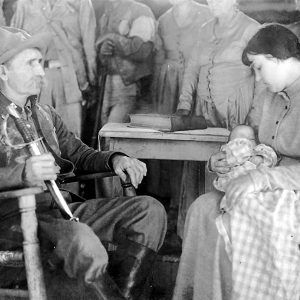calsfoundation@cals.org
Souls Aflame
aka: Thou Shalt Not Kill
Written and directed by Raymond Wells, Souls Aflame (1928) was a late-silent-era film made either entirely or partly in Norfork (Baxter County). The movie is sometimes described as a Civil War film, but it dealt with a fictitious feud between the Buck and Lilly families during Reconstruction. Souls Aflame may have been the first movie filmed largely or entirely in Arkansas. It is now considered a lost film.
One valuable secondary source with authoritative information on this movie is the American Film Institute Catalog of Feature Films Produced in the United States: Feature Films, 1921–1930. Entries in the catalog were based on copyright information and articles and reviews in contemporary periodicals. The entry on Souls Aflame reads, “Drama. Shortly after the Civil War a feud begins over the murder of a Lilly by five Buck boys, who are acquitted by a jury in deference to the judge, a kin of the Bucks. Years later the dead Lilly’s son becomes a preacher, tries to bring peace to the mountains, and falls in love with a Buck girl. He is abused for ‘enticing’ the girl to church, and his mother insists on eradicating the Bucks once and for all. There is a bloody battle in which all of the Bucks are killed except for the girl, who refuses to carry on the feud and marries the preacher.” They add a note: “Filmed partly in the Ozarks.”
This short summary is supplemented by a review in Variety (July 18, 1928). The reviewer is enthusiastic about the “well written, well produced and well played” movie, but complains that “the sure-seat operators” (exhibitors) had “passed this one up.” The review notes that while “all of the Bucks are killed except for the girl,” this does not mean that a large family was exterminated to provide an end to the stubborn feud. The five Buck brothers are the whole Buck faction, and they are killed.
The Variety review also makes clear why the five Bucks are thoroughly bad: “Throughout there is a convincing picturization of a half-civilized, semi-barbarous folk.” They are characterized by “their hatred and intolerance of the church” and “the leering condescension toward those with ‘book learning.’” When a young woman cousin enters the home of the Bucks, the review says, “first the boys sniff suspiciously and about five seconds after the spokesman introduces her there is a chorus of outbursts to the effect that no loafing females are wanted and ‘Tell her to prepare some vittles.’” The final phase of the feud begins when the young Lilly preacher is “beaten up on the charge of ‘enticing’ the girl to church.” The Buck men are anti-Christian, tyrants in their dealings with women, and habitually violent.
Oddly, the Variety reviewer claimed that the film shows a “60-year-old feud.” That would mean that the filmmakers covered so much time that the finale of the movie was contemporaneous with the release of the film. This seems unlikely, since the Lilly whose murder began the feud is the father of the man referred to as “the young preacher” to the end of the story, when he marries a young woman.
The actors used in the movie consisted of Hollywood professionals and local amateurs. The five Buck brothers were played by professional Gardner James and local men Mitchell Payne, Bill Hamilton, John Southard, and Doug Woods. Details about the production are provided by Mary Ann Messick in her book The History of Baxter County and Martha White Lee in her article “A Look Back: Hollywood Comes to Baxter County” in the Baxter Bulletin. Lee reports that when the film needed actors to play a scene of reconciliation between weary Union and Confederate troops at the end of the War, “Some of the old Confederate veterans refused to drape themselves with the blue,” but some men of the “younger generation” agreed to portray the Yankees. Messick recalls, “Needless to say, when ‘Souls Aflame’ first showed at the Lyric Theater in Norfork, it played to a packed house of nervous ‘actors,’ anxious to see how they came across on the screen.”
Souls Aflame was released in 1928, just as silent films began to be overwhelmed by talkies. This fact, combined with the lack of interest major distributors had in the film, makes its commercial failure and subsequent status as a lost film unsurprising. However, producer James Ormont made a strong effort to draw attention to his film. He even arranged a British release beginning on January 9, 1928, two months before the March 10 American premiere.
For additional information:
The American Film Institute Catalog of Feature Films Produced in the United States: Feature Films, 1921–1930. Berkeley: University of California Press, 1997.
Lee, Martha White. “A Look Back: Hollywood Comes to Baxter County.” Baxter Bulletin, March 2, 2014. Online at https://www.baxterbulletin.com/story/news/2014/03/03/a-look-back-hollywood-comes-to-baxter-county/5961051/ (accessed September 3, 2021).
Messick, Mary Ann. History of Baxter County, Centennial Edition, 1873–1973. Mountain Home, AR: Mountain Home Chamber of Commerce, 1973.
“Souls Aflame.” Internet Movie Database. https://www.imdb.com/title/tt0165951/?ref_=nv_sr_srsg_0 (accessed September 3, 2021).
Michael Klossner
Little Rock, Arkansas
 Arts, Culture, and Entertainment
Arts, Culture, and Entertainment Early Twentieth Century, 1901 through 1940
Early Twentieth Century, 1901 through 1940 Souls Aflame
Souls Aflame 



Comments
No comments on this entry yet.